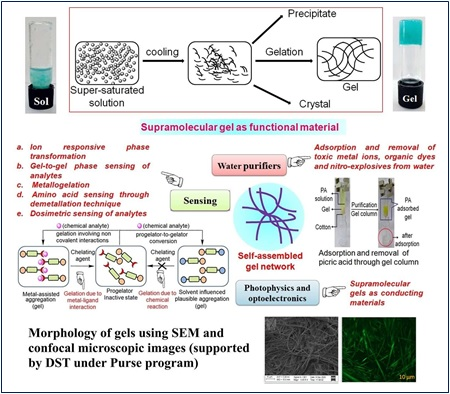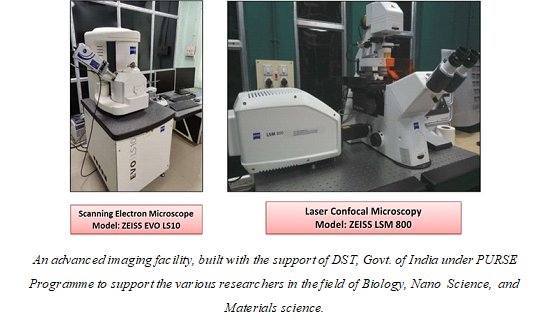Researchers have designed and synthesized a bunch of smart materials that can easily detect biologically relevant ions visually and can remove toxic dyes and chemicals like picric acid from water. The materials called supramolecular gels undergo transition from gel-to-sol or vice versa, or gel-to-gel in the presence of biologically relevant ions, which are targeted to be detected and adsorb various dyes from wastewater.
The solution phase recognition of ions by employing different sophisticated instruments such as fluorescence, UV-vis, and NMR is a conventional way in the area of sensing and recognition. In addition to such existing technologies, researchers are trying to detect toxic materials from the semisolid state, of which supramolecular gel is worth mentioning.
Supramolecular gels are versatile and unique for the mastery of noncovalent interactions that can be tuned, controlled, easily broken, and reformed reversibly. Owing to these features, they are used as smart gels in many areas such as drug delivery, optoelectronics, catalysis, tissue engineering, sensing, and environmental remediation, etc. The ‘smart’ nature arises from the responsiveness of the gels towards different external stimuli such as pH, light, redox, ions, ultrasound, mechanical stress, etc. Exposure of gels to such different stimuli changes the molecular level interactions that result in various macroscopic changes of gels. Thus there is immense scope for using them as gelation-based visual sensors that can reduce the necessity of sophisticated spectroscopic tools.

Prof. Kumaresh Ghosh and his group at the University of Kalyani have been actively involved in working on fundamental and applied aspects of Supramolecular Chemistry using an advanced imaging facility built with the support of the Department of Science and Technology, Govt. of India under the PURSE Programme.
They have developed a new material called naphthalimide-linked new phenol derivative for selective sensing of cyanide ions (CN−) in sol-gel medium. The reagent can be used for aqueous detection of bio-relevant ionic species in the gel state without using sophisticated instruments. The design and synthesis of this new material has been published in the journal Analytical Methods. Along with this, another material called sulfonyl hydrazone cholesterol conjugate which exhibits a selective response toward cyanide (CN−) and fluoride (F−) ions causing gel-to-sol transformation and removes anionic dyes, such as erythrosine B and uranine, from water has been fabricated. The researchers have also derived supramolecular gels from dehydroabietylamine-decorated imino-phenols, which can sense and detect metal ions such as Fe3+, Cu2+, and Hg2+. Both these findings have been published in the New Journal of Chemistry. The use of gel materials in biological fluid for detection is underway in the laboratory.
To explore the supramolecular gels as smart materials in material chemistry, the researchers are designing new gelators that find application in ion sensing and toxic chemical removal from wastewater. They plan to take their work further by fabricating the metallogels as conducting materials in collaboration with other scientists.
Publications:
A naphthalimide-linked new pyridylazo phenol derivative for selective sensing of cyanide ions (CN−) in sol-gel medium, Ghosh, S.; Jana, P, and Ghosh, K. Analytical Methods, 2021, 13, 695-702 https://doi.org/10.1039/D0AY02033H

A sulfonyl hydrazone cholesterol conjugate: gelation, anion interaction and its application in dye adsorption, Panja, A.; Ghosh, S and Ghosh, K. New J. Chem., 2019,43, 10270-10277 https://doi.org/10.1039/C8NJ05613G






























